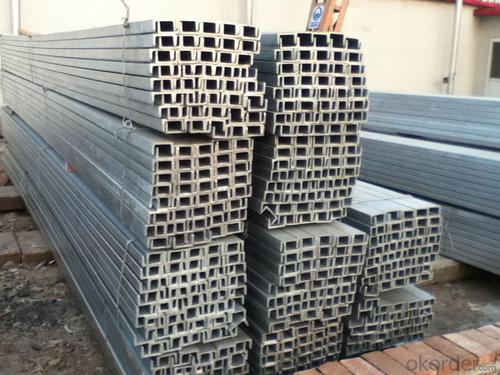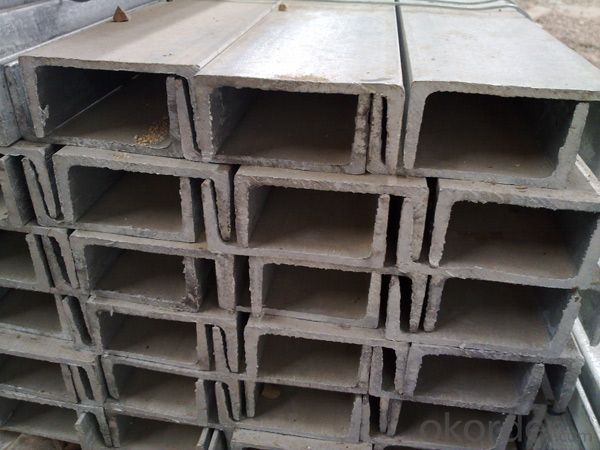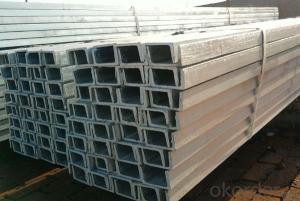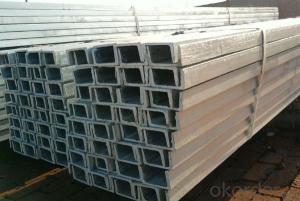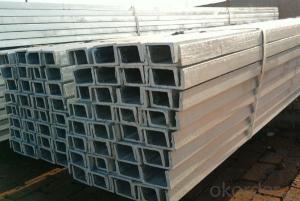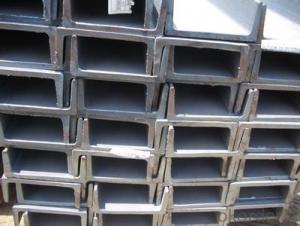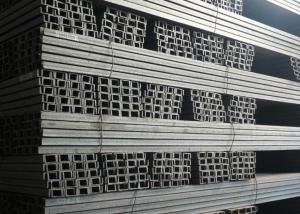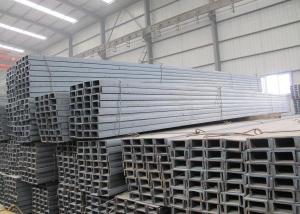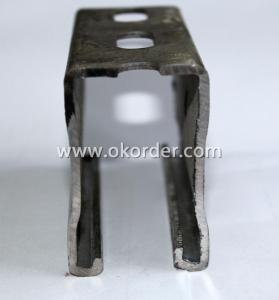JIS U CHANNEL high quality hot rolled all sizes
- Loading Port:
- Tianjin
- Payment Terms:
- TT OR LC
- Min Order Qty:
- 25 m.t.
- Supply Capability:
- 100000 m.t./month
OKorder Service Pledge
OKorder Financial Service
You Might Also Like
channel Details:
| Minimum Order Quantity: | Unit: | m.t. | Loading Port: | ||
| Supply Ability: | Payment Terms: | Package: | wire rod bundle |
Product Description:
Product Description:
Specifications of MS Channel:
1.We supply high quality MS Channel at reasonable price, including Chinese standard, Japanese standard and so on.
Standard | GB/JIS |
Material Grade | Q235,SS400 |
Technique: | Hot Rolled |
Sizes as per chinese standard: | 50*37*4.5mm - 300*89*11.5mm |
Sizes as per japanese standard: | 50*25*3mm – 200*80*7.5mm |
Length: | 6meter, 9meter, 12meter |
Note: 1.we are also competent to provide our customers other MS Channel based on other sizes according to customer’s requirements.
2. The length of our ms channel could be cut into other meters as per customer’s requirements. For example, the channel in 6meters could be cut into 5.8meters in order to be fit in the 20ft container.
2. The detailed sections of MS Channel as per GB standard.are shown in the table-1:
GB U CHANNEL | Standard | Sectional | Dimension |
| Mass: |
(mm) | (mm) | (mm) | (mm) | ||
50X37 | 50 | 37 | 4.50 | 7.0 | 5.438 |
63X40 | 63 | 40 | 4.80 | 7.5 | 6.634 |
80x43 | 80 | 43 | 5.00 | 8.0 | 8.045 |
100x48 | 100 | 48 | 5.30 | 8.5 | 10.007 |
120x53 | 120 | 53 | 5.50 | 9.0 | 12.059 |
140x58 | 140 | 58 | 6.00 | 9.5 | 14.535 |
140x60 | 140 | 60 | 8.00 | 9.5 | 16.733 |
160x63 | 160 | 63 | 6.50 | 10.0 | 17.240 |
160x65 | 160 | 65 | 8.50 | 10.0 | 19.752 |
180x68 | 180 | 68 | 7.00 | 10.5 | 20.174 |
180x70 | 180 | 70 | 9.00 | 10.5 | 23.000 |
200x73 | 200 | 73 | 7.00 | 11.0 | 22.637 |
200x75 | 200 | 75 | 9.00 | 11.0 | 25.777 |
220x77 | 220 | 77 | 7.00 | 11.5 | 24.999 |
220x79 | 220 | 79 | 9.00 | 11.5 | 28.453 |
250x78 | 250 | 78 | 7.00 | 12.0 | 27.410 |
250x80 | 250 | 80 | 9.00 | 12.0 | 31.335 |
250x82 | 250 | 82 | 11.00 | 12.0 | 35.260 |
280x82 | 280 | 82 | 7.50 | 12.5 | 31.427 |
280x84 | 280 | 84 | 9.50 | 12.5 | 35.823 |
280x86 | 280 | 86 | 11.50 | 12.5 | 40.219 |
300x85 | 300 | 85 | 7.50 | 13.5 | 34.463 |
300x87 | 300 | 87 | 9.50 | 13.5 | 39.173 |
300x89 | 300 | 89 | 11.50 | 13.5 | 43.883 |
Table-1
3. The chemical composition of HR Channel Steel according to Q235B is shown in Table-2.
Alloy No | Grade | Element(%) | ||||
C | Mn | S | P | Si | ||
Q235 | B | 0.12-0.20 | 0.3-0.7 | ≦0.045 | ≦0.045 | ≦0.3 |
Table-2
Note: we are able to present our customers relevant SGS test report for chemical composition of HR Channel Steel.
4. The mechanical property of HR Channel Steel according to Q235B is shown in Table-3-1 and Table-3-2
Alloy No | Grade | Yielding Strength Point(Mpa) | |||
Thickness(mm) | |||||
≦16 | >16-40 | >40-60 | >60-100 | ||
≧ | |||||
Q235 | B | 235 | 225 | 215 | 205 |
Table-3-1
Alloy No | Grade | Tensile Strength(Mpa) | Elongation After Fracture(%) | |||
Thickness(mm) | ||||||
≦16 | >16-40 | >40-60 | >60-100 | |||
≧ | ||||||
G235 | B | 375-500 | 26 | 25 | 24 | 23 |
Table-3-2
Note: we are able to present our customers relevant SGS test report for mechanical property of MS Channel as customer’s request.
Applications of MS Channel:
The MS Channel can be applied to construction of warehouses, workshops, sport stadiums and car parks etc.The hot rolled channel steel belongs to carbon structural steel which is applied to in the field of construction and machinery.In details, the hot rolled channel steel is usually used for arch-itechtural structure, and they could be welded in order to support or hang a vari-ety of facilities. They are also usually used in combination with I beam. Generally,the hot rolled channel steel we supply must possess perfect welding property, riveting property and mechanical property and so on.
Package & Delivery of MS Channel:
1.The hot rolled channel steel will be packed in bundle with steel wire at each end of every bundle and color marking in order to help the customer to recognize his goods more easily at sight.
2. And the hot rolled channel steel could be loaded into 20ft or 40ft container, or by bulk cargo.If the weight of each bundle reaches more than 3.5 mt, the loading by break bulk cargo should be choosed.When the weight of each bundle reaches less than 3mt, the loading by container should be choosed.
3.As for the transportaion from mill to loading port, the truck will be usually used. And the maximum quantity for each truck is 40mt.
4.All in all, we could do in accordance with customer's request
- Q: Can steel channels be used in earthquake-prone areas?
- Yes, steel channels can be used in earthquake-prone areas. Steel is known for its strength and durability, making it a suitable material for construction in areas prone to earthquakes. Steel channels provide structural support and can withstand seismic forces, making them an ideal choice for earthquake-resistant building designs. Additionally, steel's flexibility allows it to absorb and dissipate energy during earthquakes, reducing the risk of structural damage.
- Q: Are steel channels suitable for seismic retrofitting?
- Yes, steel channels are suitable for seismic retrofitting. They provide excellent strength and flexibility to withstand seismic forces and can be used to reinforce and strengthen existing structures to improve their resistance to earthquakes.
- Q: Is the track steel often called channel or construction steel?
- See what you do, oh. Anyway, with the "beam" on the general use of I-beamChannel steel is usually made of steel structures and is matched with other types of steel
- Q: What are the different methods of protecting steel channels from rust?
- There exist various methods for safeguarding steel channels against rust. 1. Galvanization: A widely employed technique entails coating the steel channels with a layer of zinc. This zinc coating acts sacrificially, shielding the steel from corrosion. Galvanized steel channels exhibit high resistance to rust, even in harsh surroundings. 2. Powder coating: This method involves the application of a dry powder onto the steel channel's surface, followed by heating to generate a protective layer. Powder coating offers exceptional corrosion resistance and an assortment of color options. 3. Application of paint or primer: By applying a layer of paint or primer to the steel channels, one can protect them against rust. The paint forms a barrier between the steel and its environment, preventing moisture and oxygen from reaching the metal surface. 4. Epoxy coating: Industrial settings often employ epoxy coatings to safeguard steel channels from corrosion. These coatings possess excellent adhesion, chemical resistance, and durability, thus providing long-lasting protection against rust. 5. Stainless steel: Opting for stainless steel channels proves an effective means of rust prevention. Stainless steel comprises a significant percentage of chromium, which creates a passive protective layer on the surface, rendering it highly resistant to corrosion. 6. VCI (Volatile Corrosion Inhibitors): VCI films or papers can be utilized to wrap or line steel channels. These materials emit vapor-phase corrosion inhibitors, safeguarding the metal surface from rust. 7. Cathodic protection: This approach involves connecting the steel channels to a sacrificial anode, such as zinc or magnesium. The anode corrodes instead of the steel, thereby protecting it from rust. Selecting the appropriate method relies on the specific environment, budget, and desired level of protection. Regular maintenance and inspection of the steel channels are crucial for detecting any signs of corrosion and taking necessary preventive measures.
- Q: How do steel channels perform in earthquake-prone areas?
- Steel channels perform well in earthquake-prone areas due to their high strength and ductility. They can effectively absorb and distribute seismic forces, providing enhanced resistance to structural damage. Additionally, steel channels can be designed to flex and bend during an earthquake, minimizing the risk of collapse and ensuring the safety of buildings and structures in these regions.
- Q: What kind of welding rod used for channel steel?
- 20 steel can use knot 422, knot 423, knot 424, knot 425; strength high occasion, knot 506, knot 507. 304 steel with Austria 102, Austria 107, Austria 002 welding rod.
- Q: Can steel channels be used in load-bearing applications?
- Yes, steel channels can definitely be used in load-bearing applications. Steel channels are commonly used in construction and engineering projects where high strength and durability are required. They are designed to provide structural support and distribute the weight of the load evenly. Steel channels are able to withstand heavy loads and offer excellent resistance against bending and twisting forces. Additionally, they can be easily customized and tailored to specific project requirements, making them suitable for various load-bearing applications such as bridges, buildings, heavy machinery, and infrastructure projects.
- Q: Are there any specific safety considerations when working with steel channels?
- Yes, there are specific safety considerations when working with steel channels. Some of these considerations include wearing appropriate personal protective equipment (PPE) such as gloves, safety glasses, and steel-toed boots to protect against potential injuries. Additionally, workers should be cautious of sharp edges and corners on steel channels, as they can cause cuts and abrasions. Proper lifting techniques and equipment should be used to prevent strains or back injuries when handling heavy steel channels. Finally, it is important to follow proper procedures for cutting, welding, and drilling steel channels to prevent fire hazards and exposure to harmful fumes.
- Q: What does channel C10 mean? What is the full name of C?
- Decent channel steel, with two thicker legs, does not curl (it rolls too tightly). Used for stressed structures.
- Q: What are the different cross-sectional shapes of steel channels?
- Steel channels are structural components that come in various cross-sectional shapes and are commonly used. The different shapes of steel channels include C channels, U channels, and Z channels. C channels, also referred to as C-sections or C beams, have a distinctive profile in the shape of a C. They have a wide top and a narrow bottom, with two flanges that extend outward at a right angle from the web. C channels are used in construction and engineering applications to provide structural support and stability. U channels, also known as U-sections or U beams, have a profile in the shape of a U. They have parallel flanges that connect through a web in the center. U channels are widely utilized in manufacturing and industrial applications, specifically in conveyor systems, support structures, and framing. Z channels, also referred to as Z-sections or Z beams, have a profile in the shape of a Z. They have a vertical web with two flanges that are angled outward in opposite directions. Z channels are frequently employed in construction and architectural applications to provide strength and stability in various structural elements such as roof purlins and wall studs. Each of these cross-sectional shapes possesses distinct characteristics and advantages, which make them suitable for different applications. The selection of a steel channel shape depends on factors such as load-bearing requirements, structural design, and specific project needs.
Send your message to us
JIS U CHANNEL high quality hot rolled all sizes
- Loading Port:
- Tianjin
- Payment Terms:
- TT OR LC
- Min Order Qty:
- 25 m.t.
- Supply Capability:
- 100000 m.t./month
OKorder Service Pledge
OKorder Financial Service
Similar products
Hot products
Hot Searches
Related keywords



